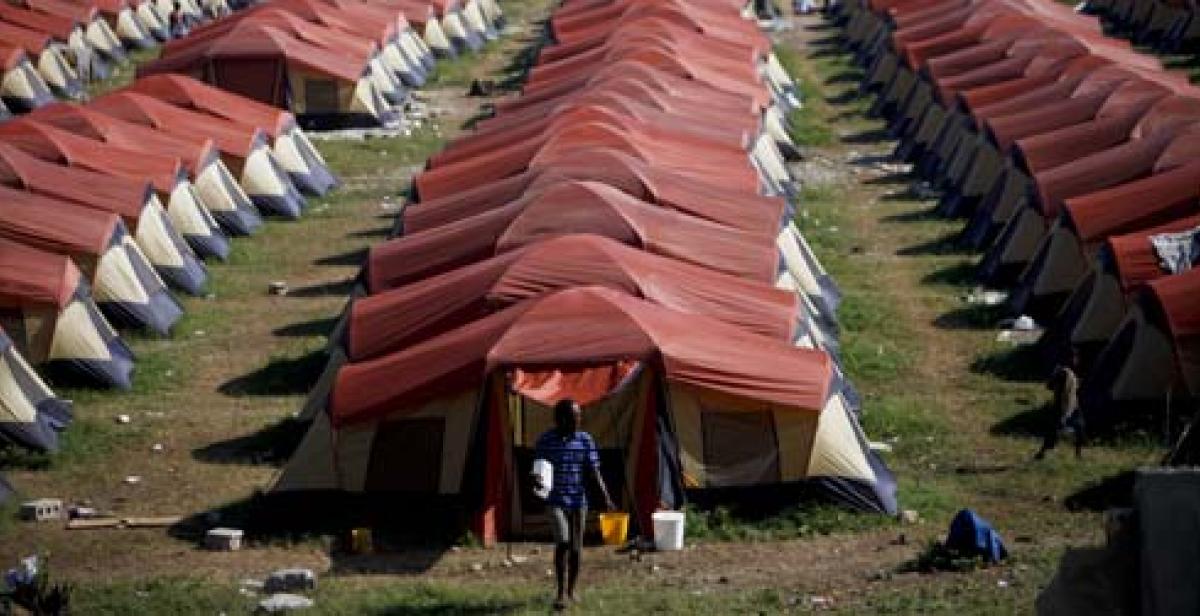This picture of a tent city outside Port-au-Prince in Haiti strangely reminds me of my holiday last summer, writes Progressio staff member Esther Trewinnard. We had a similar tent. But, after two weeks of sunny camping in Wales, the great British weather declared enough was enough and turned on us – as it does.
Our tent was all but blown away, off the edge of a cliff and into the sea. We dashed about rescuing our belongings and broken tent poles – my 8-month-old son thankfully all snug and warm in the car. I really hope this is the closest I ever come to my home being destroyed by a natural disaster.
Our somewhat dramatic experience had all the makings of a ‘mini adventure’, but was of course worlds away from what happens in a real emergency, such as the earthquake that hit Haiti last year.
Put me in a tent city
From a cosy terraced house in London, it’s not easy to imagine the reality of what the people living in this tent city have survived over the last year and are still going through. So today when I met Nicolo Schiaparelli, the new sub-regional manager for Progressio Hispaniola (the island consisting of Haiti and the Dominican Republic), I asked him to put me in a tent city in Port-au-Prince.
When the earthquake hit in January 2010, my own son was just two months old. I asked Nicolo what life in the tent city would be like for a mother with a young baby. “People live very close together. You’d probably have access to water, but there are no toilets,” he told me. I don’t need to be reminded of the risk of cholera.
“And at night, in the dark, women and children are particularly vulnerable to abuse,” he continued. “For those in the tent city there are more difficult challenges to face ahead, but out of vulnerability an attitude of solidarity is emerging, and normal life is carrying on. Babies are being born. Children are playing and having fun.”
Moving on
A year later and a baby this time last year may have survived to take their first steps in the tent city that has become home. But what hope is there for people to move on, out of what was always intended as temporary accommodation?
Only 5% of the rubble has been cleared, leaving the bodies of those who didn’t survive unrecovered. “Unemployment is at 80%. Who will pay to rebuild homes?” Nicolo asks. “People are getting too used to waiting for someone to help. The challenge for civil society organisations now is to create jobs so that people can help their own situations.”
Although the challenges facing Haiti have magnified over the last year, Nicolo believes that the earthquake has created “a new spirit of solidarity between Haitian and Dominican civil society organisations that will help to build better bi-national relations and better understanding on the economic, social and political challenges facing Hispaniola.”
As I plan my next ‘mini adventure’ on a cliff top in Wales, I hope and pray that this year the tents in Haiti will start to be taken down as people start rebuild their lives and homes.
Esther Trewinnard is Progressio’s communications officer based at Progressio’s head office in London.
Progressio has 14 development workers on the Caribbean island of Hispaniola: 2 in Haiti, 2 in the Dominican Republic and 10 in the border region, working on bi-national relations and cross-border issues. Our aim is to link civil society with government municipalities to ensure ordinary people participate in local development and budgeting. Nicolo hopes this will contribute to creating a long-term culture of understanding and collaboration between the two countries.
Photo © Natasha Fillion/Progressio



